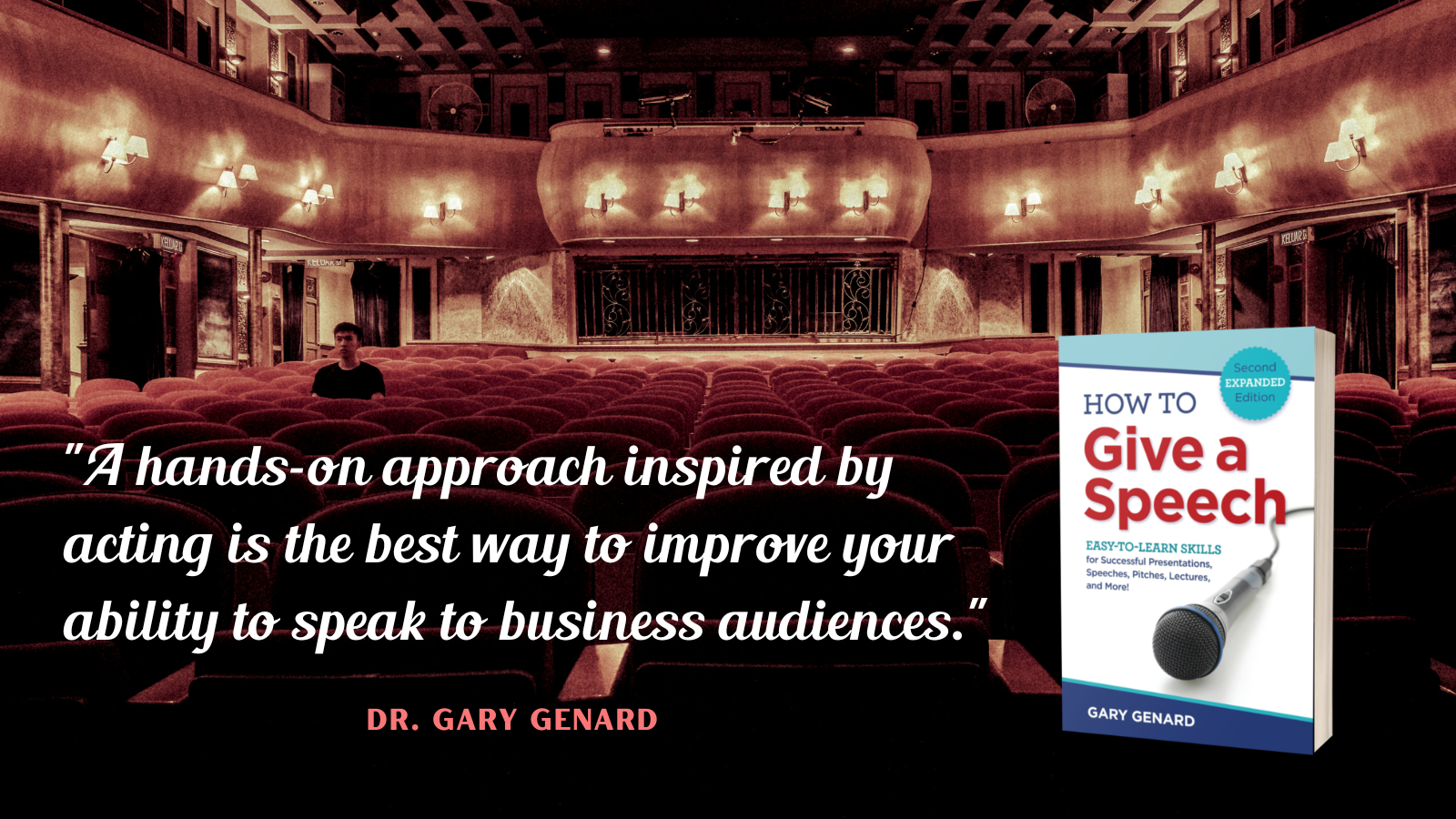Your physical expressiveness is key to moving and motivating audiences. But be careful! Here are 5 body language errors that can sink your presentations.
Do you express yourself fully when you speak? You may say yes. But I'm talking about using the language of your body.
Yes—body language. It's a key skill when it comes to moving, motivating, and inspiring listeners. And unfortunately, there's a lot of paint-by-numbers advice out there about it. Follow that advice if you want to stay confused and in the weeds. Otherwise, keep reading.
Read Chapter 9, "The Visual You: Body Language," in my Public Speaking Handbook, How to Give a Speech. Discover 101 quick tips for powerful speaking. Also find it on Amazon.
If, on the other hand, you want to understand how true leaders move when they speak in public, you have to take a different approach. That's what we do at The Genard Method, where I tell my speech coaching clients to forget the how-to advice. How many leaders do you know who hold themselves and move in specific ways because someone told them they ought to do so?
Instead, invest yourself in accepting this general rule: Do what you find natural in terms of movement. Make your physical performance spontaneous yet controlled. In other words, learn how to create natural movement and gestures.
Use nonverbal communication to boost your stage presence. Get my Free cheat sheet, "Body Language: 6 Skills Building Exercises." Add these skills to your toolbox!
Performance Habits to Recognize and Avoid
Prescriptions for public speaking—"Do this so you appear natural"—simply don't work. It's more helpful to learn how to avoid the errors that will brand you as an amateur. I discuss five of those errors below. Avoid them if you want your presentations to be engaging, rather than ones that elicits sly grins and rolling eyes (now there's an easy-to-read gesture).
1. Using Weak Eye Contact with Your Audience
What's happening here? Is the speaker's name written on those 3 x 5 cards? Does he or she need to be reminded of the name of their company?
Of course not. The real culprit is self-consciousness. Notes or a PowerPoint deck are familiar objects in a sea of strangers—in fact, speakers are using them as life preservers. But your opening is the moment when you connect with audiences and establish rapport. So those audiences need you to look at them 100% of the time.
2. Posture Matters! — Adopting a Weak or Unbalanced Stance
What about posture? It's something we don't think about enough in terms of public speaking. But remember this simple statement: How you stand affects your standing with an audience.
In other words, posture is related to knowing how to command a stage. When your posture draws attention to itself, or you assume a weak stance (such as crossed ankles, which can even be seen in the upper body if you're standing behind a lectern), you appear literally unbalanced. What kind of status is that for someone giving a presumably important speech? Chances are you'll be giving the opposite impression of the one you're trying to achieve! Instead, ground yourself by placing your feet flat on the floor at armpit width. Now you look steadfast!
3. Closed Gestures Are a Sign of an Insecure Public Speaker
Crossed arms. The "fig-leaf position" with hands cupped in front of your crotch. Making "church steeples" with your hands or twirling your wedding band with the opposite hand. Self-consciousness often causes us to use gestures to wall ourselves off. After all, you probably feel exposed and vulnerable. So why not protect yourself?
Because it closes you off from those all-important listeners! You need just the opposite, of course: to open up and reach stakeholders, emotionally as well as intellectually. What those crossed arms and hands-held-together gestures are really doing, is alerting the audience that you're creating a barrier between you and them and hiding behind it. Listeners will automatically have less than total confidence in you. Find out here if you're committing any of the 7 deadly sins of nonverbal communication.
4. Poor Use of Space So You Don't Command the Room
Good public speakers command the space that is due them when they speak. They use the space that's rightfully theirs. After all, performing on a stage of any kind—from conference room to auditorium—means being in the spotlight, usually center-stage-with-all-eyes-on-you.
Shy or reluctant speakers don't move purposefully in these situations. They may even try to diminish their presence by folding in on themselves to occupy a smaller space. If, on the other hand, you want to have some physical impact, you must fill your space. How? Use most or all of that space. Approach your audience if you can. Move toward your PowerPoint screen to point something out. And, most important, free yourself from the lectern whenever possible.
5. The Tiger-in-the-Cage (Side) Show
Finally, learn a lesson from the world of bad motivational speaking. If you're saying something interesting, if you're knowledgeable and passionate about your topic, and if it truly meets some need in listeners, what you say will be interesting and perhaps even exciting. A problem arises, however, when a speaker tries desperately to generate excitement where none inherently exists.
You've seen these performances, where the motivator strides (or runs) back and forth across the stage, gesticulating wildly, shouting "Give it up!" or "Are you READY!" Personally, I always feel exhausted by these performances, even though I haven't moved an inch.
Excellent speakers stay grounded in the reality of not only what they're saying, but what they're showing. You need physical expression of your talk. And that lies in a secure stance and powerful and appropriate gestures. It doesn't lie in the circus-like atmosphere of pacing back and forth across the stage like a tiger in a cage. If you trust the honesty of your message and this moment of connecting with your audience, your listeners will see it that way too.
You should follow me on Twitter here.






